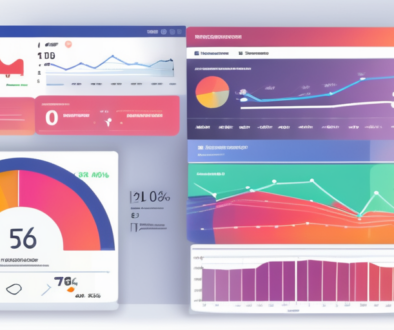Stop Guessing! Track These LinkedIn Ad Metrics for Maximum Impact
In the world of digital marketing, understanding and measuring the right metrics is crucial for the success of any advertising campaign. LinkedIn, as a professional networking platform, offers unique advertising opportunities that necessitate specific metrics for evaluation. This article explores the most important LinkedIn ad metrics you need to track, helping you refine your strategies and optimize your campaigns for better results.
Cracking the Code: How LinkedIn Ad Metrics Work
To effectively measure the performance of your LinkedIn ads, it’s essential to understand what ad metrics are and the data they provide. These metrics are quantifiable values that give you insights into how your advertising campaigns are performing. By analyzing these metrics, marketers can make informed decisions that lead to improved outcomes.
The Role of LinkedIn Ad Metrics
LinkedIn ad metrics play a pivotal role in evaluating the effectiveness of your advertising efforts. They help you gauge the overall performance of your ads and determine what is working and what isn’t. By tracking these metrics, businesses can identify trends, assess the return on investment (ROI), and make necessary adjustments to enhance their strategies. For instance, if you notice a high number of impressions but low clicks, it may indicate that your ad copy or visuals need refinement to better resonate with your target audience.
Key Terms in LinkedIn Ad Metrics
Familiarizing yourself with key terms related to LinkedIn ad metrics enables you to communicate more effectively and analyze data accurately. Some of the essential terms include:
- Impressions: The number of times your ad is displayed on a user’s screen.
- Clicks: The total number of times users click on your advertisement.
- Leads: Contacts captured through forms or event sign-ups as a result of your ad campaign.
- Conversions: The completed desired actions as defined by your business goals.
Understanding these terms will provide a firm foundation for analyzing the metrics that follow. Additionally, it’s important to consider metrics such as click-through rate (CTR), which measures the percentage of impressions that resulted in clicks, giving you a clearer picture of your ad’s effectiveness. A high CTR often reflects engaging content that resonates with your audience, while a low CTR may prompt a reevaluation of your targeting and messaging strategies.
Moreover, delving deeper into audience insights can enhance your understanding of how different segments interact with your ads. For example, analyzing demographic data can reveal which age groups or industries are most responsive to your campaigns, allowing you to tailor future ads to better meet their interests and needs. This level of analysis not only optimizes your current campaigns but also informs your long-term advertising strategies, ensuring that your efforts are aligned with the preferences of your target audience.
Essential LinkedIn Ad Metrics to Monitor
When it comes to tracking your LinkedIn advertising performance, there are several key metrics that you should consistently monitor. Each one provides critical insight that can contribute to a successful campaign.
Click-Through Rate (CTR)
The Click-Through Rate (CTR) is a significant metric that measures the percentage of individuals who click on your ad after seeing it. It’s calculated by dividing the number of clicks by the number of impressions and then multiplying by 100 to get a percentage.
A high CTR typically indicates that your ad is relevant and compelling to your target audience. Conversely, a low CTR may suggest that your ad’s messaging, visuals, or targeting needs improvement. Regularly monitoring your CTR allows you to tweak your ad approach and enhance engagement. Additionally, experimenting with different ad formats, such as carousel ads or video ads, can provide insights into what resonates best with your audience, potentially leading to improved CTR over time.
Conversion Rate
The Conversion Rate represents the percentage of users who take a desired action after clicking on your ad. This could be filling out a form, downloading a resource, or making a purchase, depending on your campaign goals.
To calculate the Conversion Rate, divide the total number of conversions by the total number of clicks, then multiply by 100. Monitoring your conversion rate helps you determine the effectiveness of your ads in captivating users and leading them to take action. Furthermore, analyzing the conversion funnel can reveal where users might be dropping off, allowing you to optimize landing pages and streamline the user experience to maximize conversions.
Impressions and Reach
Impressions refer to how many times your ad has been displayed, while reach pertains to the number of unique users who have seen your ad. Both metrics are essential for assessing the overall visibility of your campaign.
Tracking impressions allows you to understand how frequently your ad is served to users, which is crucial for brand awareness. Meanwhile, reach helps gauge how broadly your message is spreading within your target demographic. Balancing both metrics ensures that your advertising efforts achieve maximum exposure without overwhelming your audience. It’s also beneficial to segment these metrics by different audience demographics, such as industry or job title, to identify which segments are most responsive to your ads, enabling more targeted future campaigns.
Engagement Rate
The Engagement Rate measures the level of interaction users have with your ad, including clicks, comments, shares, and reactions. It’s calculated by dividing the total engagement by the total reach or impressions.
A high engagement rate is indicative of a successful ad that resonates with your audience, prompting them to interact more than just passively viewing it. Agencies and marketers should strive to create engaging content that naturally draws in interactions, benefiting both visibility and credibility. Moreover, leveraging user-generated content or testimonials can significantly enhance engagement, as these elements often foster a sense of community and trust, encouraging users to participate and share their own experiences.
Benefits of Tracking LinkedIn Ad Metrics
Tracking your LinkedIn ad metrics provides a wealth of advantages that can significantly enhance your marketing efforts. The insights gained from these metrics not only reveal current performance but also pave the way for future strategies.
Improved Ad Performance
Monitoring key metrics allows businesses to identify what aspects of their campaigns are performing well and which need adjustments. This iterative process of analysis and optimization leads to improved ad performance over time.
For instance, if data shows a high CTR but low conversion rate, this signals that while the ad captures attention, the landing page may need refinement to convert interest into action. Constantly improving your ads based on data-driven decisions ensures maximized effectiveness. Additionally, A/B testing different ad formats or messaging can reveal what resonates best with your audience, allowing you to fine-tune your approach and achieve even better results.
Better Budget Allocation
When you track ad metrics, you gain insights into which campaigns yield the best results. This information enables you to allocate your budget more effectively, focusing investment on ads that drive higher performance while potentially decreasing spend on underperforming ads.
Continually assessing ROI across several campaigns provides clarity on where financial resources will produce the highest returns, leading to enhanced budget management. Furthermore, understanding the cost per lead or acquisition for each campaign can help you make informed decisions about scaling successful initiatives or pivoting away from less effective strategies, ensuring your marketing budget is utilized in the most impactful manner.
Enhanced Audience Targeting
By analyzing metrics such as engagement rates and audience demographics, you can refine your targeting criteria for future campaigns. Insights highlighting which segments interact with your ads can help tailor your messages directly to those most likely to convert.
Moreover, monitoring feedback from metrics helps to identify emerging trends or shifts in audience behavior, allowing you to stay relevant and responsive to the needs of your target market. This proactive approach to audience analysis not only improves engagement but can also foster deeper connections with your audience, as personalized messaging tends to resonate more effectively. By leveraging advanced targeting options available on LinkedIn, such as job titles, industries, and company sizes, you can ensure that your ads reach the right people at the right time, maximizing your chances of success.
Tools for Tracking LinkedIn Ad Metrics
Effective tracking of LinkedIn ad metrics requires the right tools. Several options are available, ranging from built-in analytics to third-party solutions, each offering different features and insights.
LinkedIn’s Built-In Analytics
LinkedIn provides its own suite of analytics tools that enable advertisers to track campaign performance directly within the platform. These built-in tools offer detailed reports on impressions, clicks, CTR, conversions, and much more.
The transparency and accessibility of LinkedIn’s own analytics allow marketers to monitor their campaigns in real-time, making adjustments as necessary without the need for additional software. This immediacy can be crucial for optimizing campaigns on the fly, as marketers can quickly identify which ads are performing well and which may need tweaking. Additionally, LinkedIn’s analytics dashboard offers visual representations of data, making it easier to digest complex information at a glance.
Third-Party Tracking Tools
For those seeking more comprehensive insights, third-party tracking tools can provide additional capabilities, such as advanced reporting and integration with other marketing channels. Tools like HubSpot, Google Analytics, and Hootsuite can bridge gaps in data reporting and provide enhanced analysis.
These third-party solutions often come equipped with features like A/B testing, audience segmentation, and multi-channel tracking, which can be invaluable for marketers looking to refine their strategies. By integrating LinkedIn ad data with broader marketing metrics, businesses can gain a holistic view of their performance across various platforms. This integration allows for more informed decision-making and can help identify trends that may not be apparent when viewing LinkedIn metrics in isolation.
Moreover, some of these tools offer automation features that can save time and reduce the manual effort involved in data collection and reporting. For instance, automated alerts can notify marketers when certain thresholds are met, allowing for timely interventions. This capability ensures that campaigns remain agile and responsive to changing market conditions, maximizing the return on investment.
In conclusion, understanding and tracking the right LinkedIn ad metrics is vital for achieving successful marketing outcomes. By focusing on essential metrics, leveraging the benefits of tracking, and utilizing effective tools, businesses can optimize their LinkedIn advertising strategies and maximize their impact within the platform.



